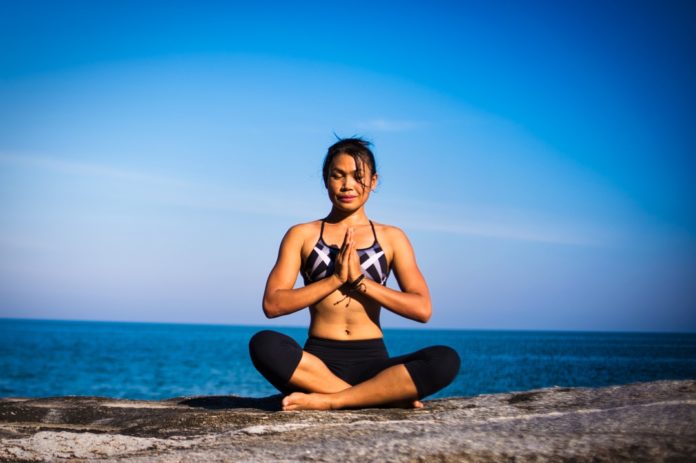Pranayama is one of the foundational practices of hatha yoga. It’s the cultivation and absorption of prana, or life force energy, into the body and mind. And just like asana (physical poses), there are many different forms of pranayama one can practice. One of the most common is the mysterious Ujjayi or “ocean sounding breath.” Incorporating the ujjayi breath in your asana practice can be difficult and feel odd. Still, there are many powerful benefits for using this breathing technique including the linking of breath to movement, increasing internal heat, boosting mental stillness, improving health, and deepening of meditation and mindfulness.
What Does Ujjayi Mean?
For most of us, our first introduction to pranayama after simple breath awareness is Ujjayi pranayama. Ujjayi is an audible breath where the inhalation and exhalation are long, deep, and complete, and move through the nose. Ujjayi is often translated from Sanskrit to mean “victorious breath,” while others describe it as an “ocean breath,” named from the “haaaa” or wave-like sound created by the air moving through a constricted glottis, or vocal cords.
Benefits of ujjayi breathing
Most beginner students wonder what is the reason for sounding like Darth Vader during yoga class. The ocean sounding breath has many powerful benefits to the body, brain, and heart. The bottom line though is that it’s a huge help during a challening yoga pose or fast paced flow. Which of the following 11 benefits have you noticed after using this traditional pranayama?
- Builds inner heat
This slow, constrained breathing builds internal body heat which makes stretching safer and prepares the body for deeper expressions of yoga poses. - Encourages cleansing
This controlled diaphragmatic breath massages the internal organs and stimulates the digestive systems to encourage detoxification and decrease phlegm. - Increases focus and concentration
The ujjayi breath links the mind, body, and spirit to the present moment and improves concentration. This cultivates richness and depth to your practice and boosts your presence and awareness. - Boosts vitality
This pranayama is used in many styles of yoga classes, like ashtanga, Jivamukti, and power yoga, as it builds endurance, energy and stamina. - Links breath with movement
The ocean breath connects the breath with movement which helps keep a steady rhythm in a flow or vinyasa style of yoga. - Reduces stress and tension
Making this calming sound encourages the release of muscular tension and activates the vagus nerve. This, in turn, switches on the “rest and renew” or parasympathetic activity of the nervous system. - Strengthens the lungs
The partial constriction of the throat lets less air through and lengthens respiration, and improves oxygen saturation. These deep breaths increase air volume, strengthens the diaphragm, and improve respiratory efficiency. - Calms the body and mind
ujjayi pranayama lowers blood pressure and slows the heart rate helping to calm the mind and reduce anxiety. - Balances the energy channels
Ujjayi pranayama cleanses and stimulates the nadis (subtle channels of the body) and encourages the activation of the Sushumna nadi to balance out the flow of prana and balance the chakra energy centers. This balancing effect helps to reduce pain, promote healing and to harmonize the endocrine system. - Lifts and stabilizes mood
The warming, focusing, and energizing effects of this pranayam increases one’s sense of aliveness and can help alleviate mild depression. - Opens the sinuses
The cranial vibration of the ujjayi breath helps open up the sinuses to relieve sinus pressure and pain from headaches.
Tips for practicing Ujjayi
Yogis all have a slightly different view of how this ancient pranayama should be practiced. Many instructors recommend a slight constricting of the throat which works for some, but the idea of that makes me uneasy. I prefer to think of it as “narrowing” the glottis or vocal cords. Better yet, I like to visualize the breath moving through the vocal cords with each round of inhalations and exhalations. I still get a sound, but it’s not especially loud, and it has the same effect: anchoring my attention to my breath. The idea is to stay connected with ujjayi for the duration of your yoga practice.
No matter what, learning ujjayi breathing takes lots of practice, on and off the mat. And depending on the teacher or class, different yoga practices dictate how loud the breath sounds and how it’s used.
How loud should Ujjayi sound?
In flow or power yoga classes, you may have heard your instructor say something along the lines of “If your neighbor on the mat can’t hear you breathing, you’re not doing ujjayi!” Or “Use your ujjayi breath to build heat and stamina.” I had one teacher proclaim, “Ancient yogis were said to be able to melt snow with their ujjayi breathing!” It’s almost as if ujjayi’s “victorious breath” has become synonymous with being victorious on the mat with the decibels of your breathing. In fact, I used to think those yogis with the loudest breath must be the most advanced practitioners. I have to admit I was a little envious. No matter how hard I tried, I couldn’t make the “ha” sound above a whisper without feeling like I was straining or forcing something to happen.
While making the ocean sound loud enough for others to hear can be helpful to learn and refine your technique, it is more important to find an engagement that is comfortable and sustainable over time. More importantly, if you are not experiencing the previously mentioned benefits, it may be a sign to adjust your technique.
Conclusion
I’ve come to learn that no matter how loud or soft, ujjayi is a means to an end: a helpful way to keep the mind and body focused. My “haaaa” sound may be only audible to me, but I feel an energy and calmness when utilizing this technique that is specific to my ujjayi breath. The rewards for using this challenging pranayama are many and great but these cannot be realized without discipline, patience and commitment.


























